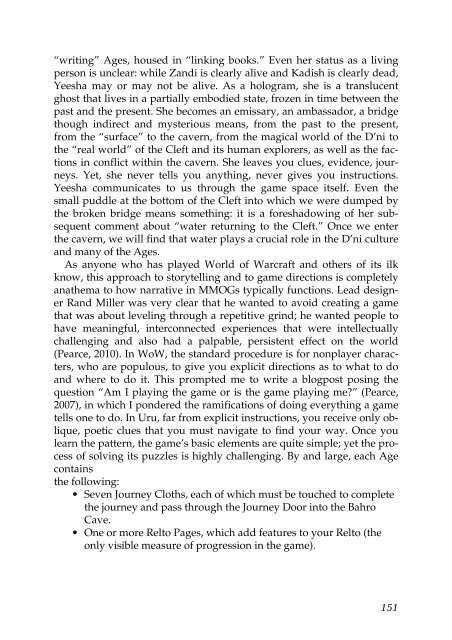Well Played 2.0: Video Games, Value and Meaning - OpenLibra
Well Played 2.0: Video Games, Value and Meaning - OpenLibra
Well Played 2.0: Video Games, Value and Meaning - OpenLibra
You also want an ePaper? Increase the reach of your titles
YUMPU automatically turns print PDFs into web optimized ePapers that Google loves.
“writing” Ages, housed in “linking books.” Even her status as a living<br />
person is unclear: while Z<strong>and</strong>i is clearly alive <strong>and</strong> Kadish is clearly dead,<br />
Yeesha may or may not be alive. As a hologram, she is a translucent<br />
ghost that lives in a partially embodied state, frozen in time between the<br />
past <strong>and</strong> the present. She becomes an emissary, an ambassador, a bridge<br />
though indirect <strong>and</strong> mysterious means, from the past to the present,<br />
from the “surface” to the cavern, from the magical world of the D’ni to<br />
the “real world” of the Cleft <strong>and</strong> its human explorers, as well as the factions<br />
in conflict within the cavern. She leaves you clues, evidence, journeys.<br />
Yet, she never tells you anything, never gives you instructions.<br />
Yeesha communicates to us through the game space itself. Even the<br />
small puddle at the bottom of the Cleft into which we were dumped by<br />
the broken bridge means something: it is a foreshadowing of her subsequent<br />
comment about “water returning to the Cleft.” Once we enter<br />
the cavern, we will find that water plays a crucial role in the D’ni culture<br />
<strong>and</strong> many of the Ages.<br />
As anyone who has played World of Warcraft <strong>and</strong> others of its ilk<br />
know, this approach to storytelling <strong>and</strong> to game directions is completely<br />
anathema to how narrative in MMOGs typically functions. Lead designer<br />
R<strong>and</strong> Miller was very clear that he wanted to avoid creating a game<br />
that was about leveling through a repetitive grind; he wanted people to<br />
have meaningful, interconnected experiences that were intellectually<br />
challenging <strong>and</strong> also had a palpable, persistent effect on the world<br />
(Pearce, 2010). In WoW, the st<strong>and</strong>ard procedure is for nonplayer characters,<br />
who are populous, to give you explicit directions as to what to do<br />
<strong>and</strong> where to do it. This prompted me to write a blogpost posing the<br />
question “Am I playing the game or is the game playing me?” (Pearce,<br />
2007), in which I pondered the ramifications of doing everything a game<br />
tells one to do. In Uru, far from explicit instructions, you receive only oblique,<br />
poetic clues that you must navigate to find your way. Once you<br />
learn the pattern, the game’s basic elements are quite simple; yet the process<br />
of solving its puzzles is highly challenging. By <strong>and</strong> large, each Age<br />
contains<br />
the following:<br />
• Seven Journey Cloths, each of which must be touched to complete<br />
the journey <strong>and</strong> pass through the Journey Door into the Bahro<br />
Cave.<br />
• One or more Relto Pages, which add features to your Relto (the<br />
only visible measure of progression in the game).<br />
151

















